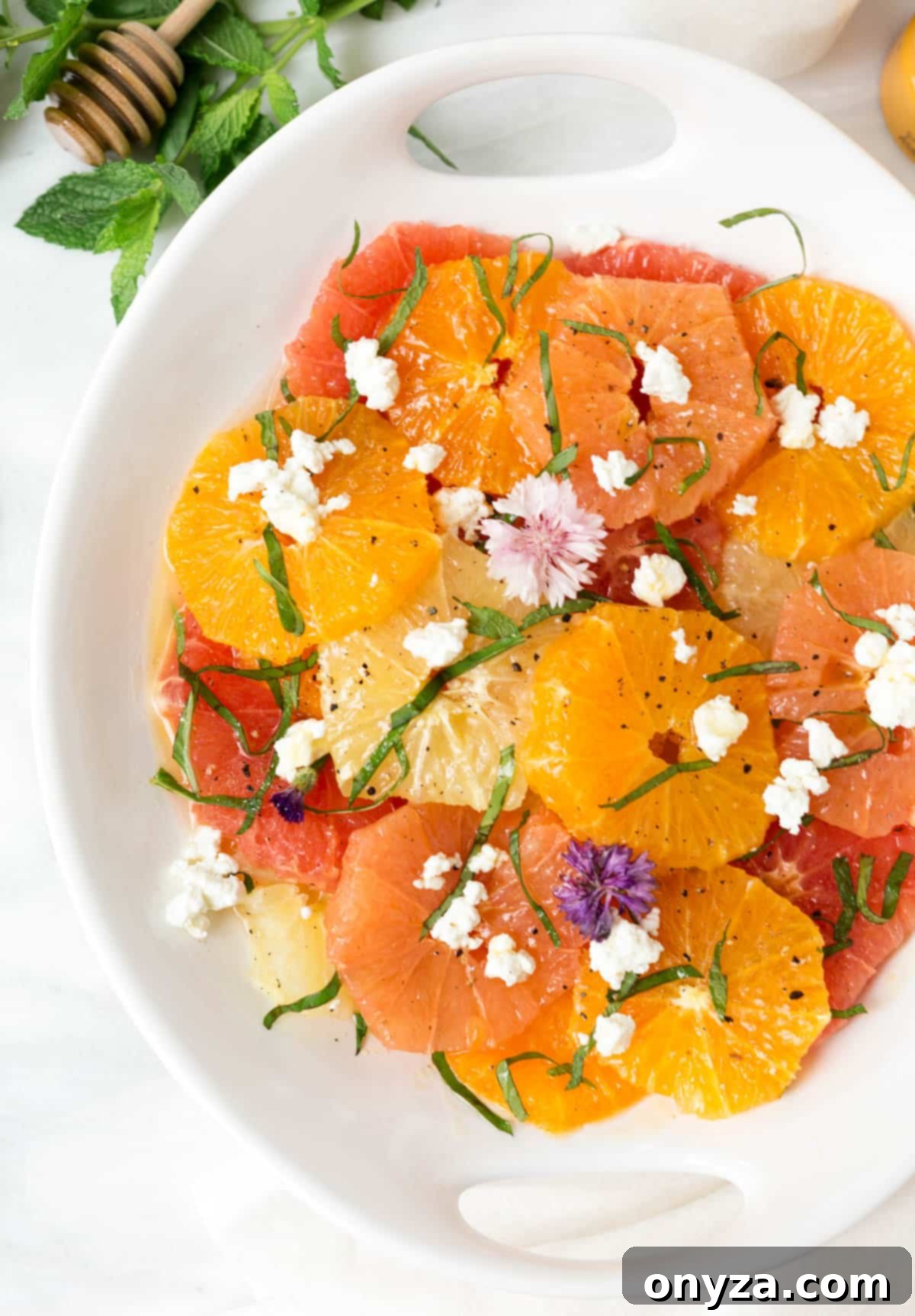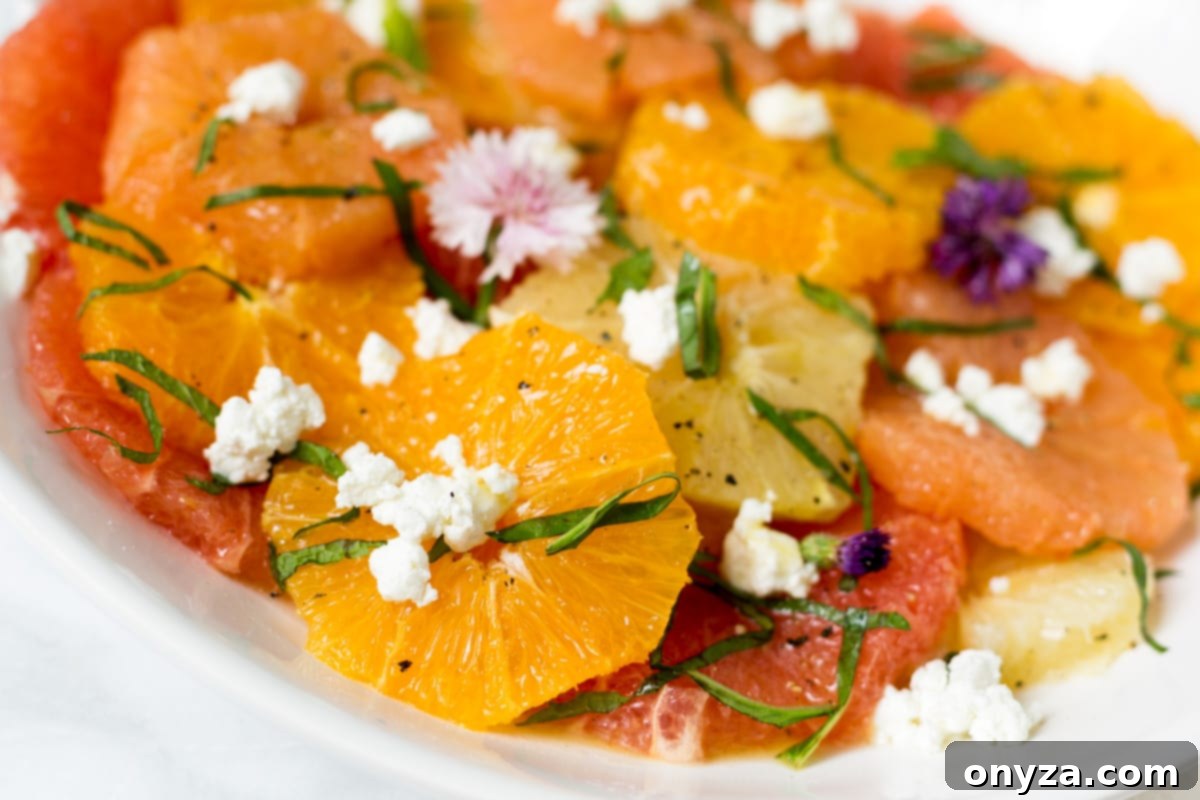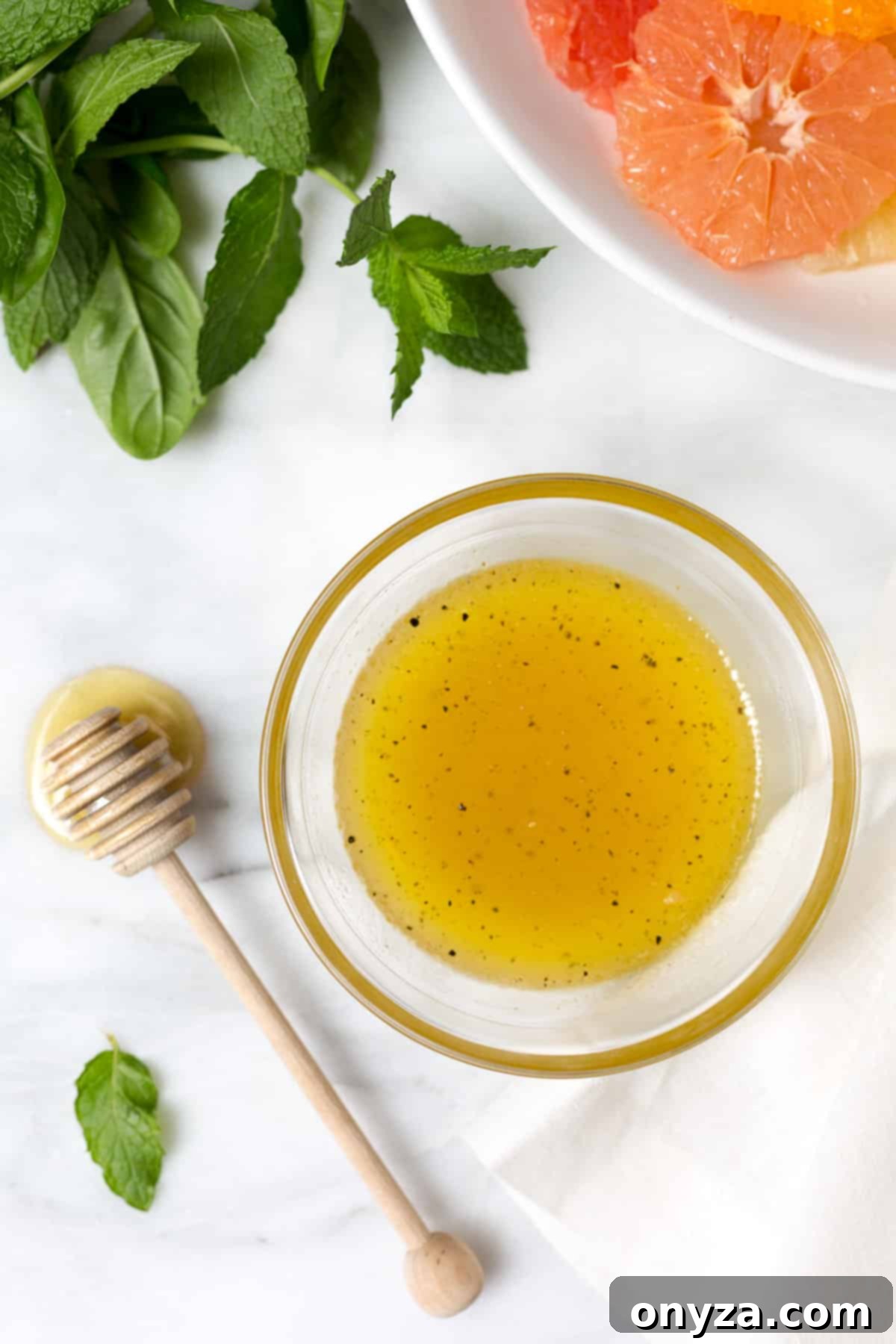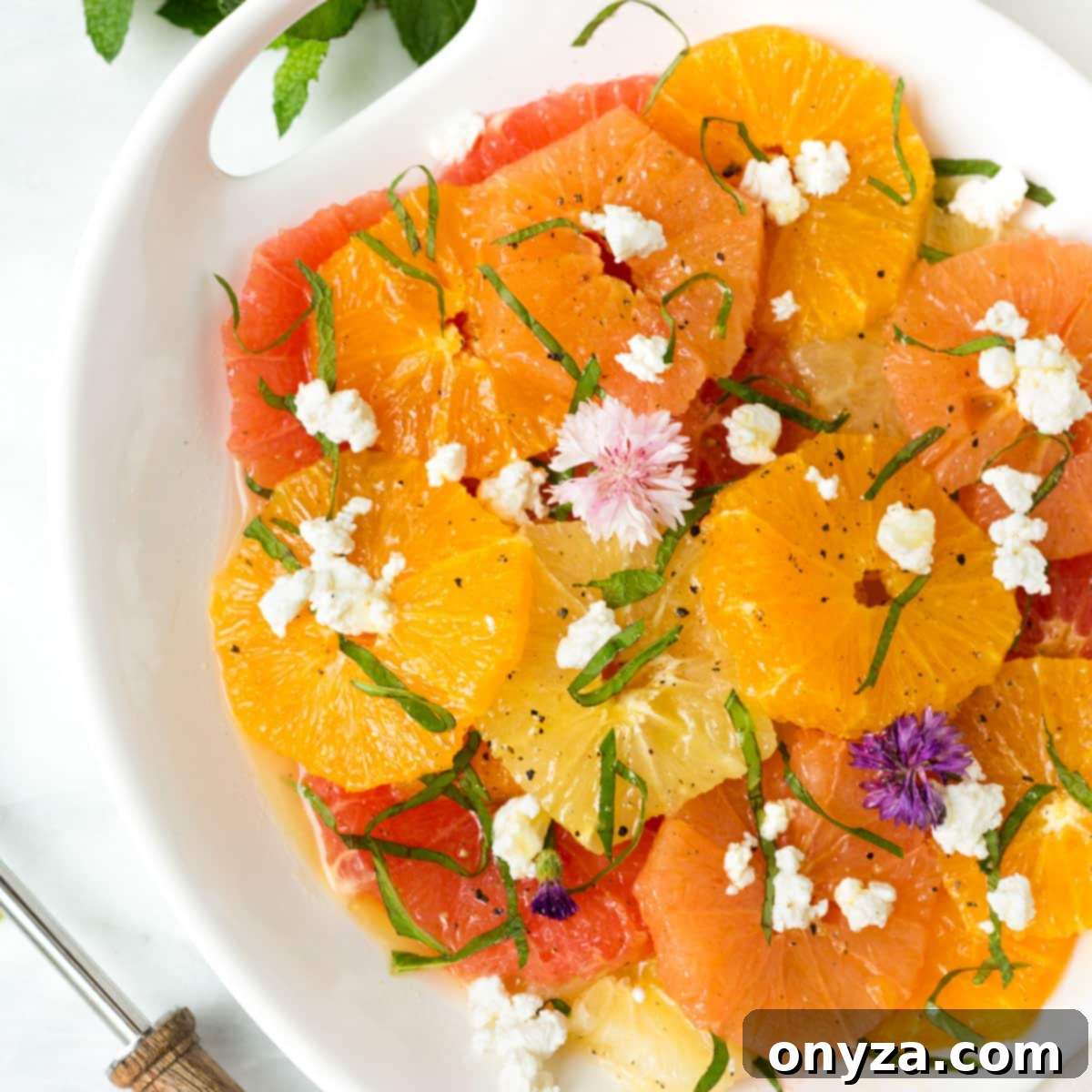Brighten your table and awaken your palate with this exquisite Mixed Citrus Salad, a refreshing culinary masterpiece that combines the vibrant flavors of freshly sliced oranges and grapefruit. Dressed in a homemade honey-balsamic vinaigrette and adorned with fresh herbs, creamy crumbled goat cheese, and a delicate sprinkle of sea salt and cracked pepper, this salad is more than just a side dish; it’s a celebration of seasonal produce. It offers a light, zesty, and visually stunning alternative to conventional salads, perfect for any meal, from a leisurely brunch to an elegant dinner accompaniment. This recipe is designed to be a delightful departure from the ordinary, promising a burst of sunshine in every bite.

This post contains affiliate links. As an Amazon Associate, I earn a commission (at no additional cost to you) from qualifying purchases made by clicking these links. As always, all recommendations and opinions expressed are my own.
Why This Mixed Citrus Salad is a Culinary Gem
This Mixed Citrus Salad isn’t just a recipe; it’s an experience. Its simplicity belies a sophisticated flavor profile and an undeniable aesthetic appeal that makes it a standout dish for any occasion. Here’s why this recipe deserves a permanent spot in your culinary repertoire:
Unforgettable Visual Appeal
The moment this salad graces your table, it transforms into a feast for the eyes. The vibrant hues of various citrus fruits—from the deep reds and delicate pinks of grapefruit to the sunny yellows and brilliant oranges of navel and blood oranges—create a mesmerizing mosaic of color. Each slice, glistening with vinaigrette, forms a beautiful contrast with the snowy white goat cheese and verdant green herbs, making this salad an instant showstopper that promises a delightful culinary journey before the first bite. Its natural beauty makes it ideal for entertaining or simply elevating a weeknight meal.
Exquisite Flavor Harmony
Beyond its striking appearance, this salad delivers an explosion of flavors that are perfectly balanced. The natural sweetness and tangy zest of the mixed citrus fruits are expertly complemented by the rich, creamy, and subtly tart notes of crumbled goat cheese. Fresh mint introduces a refreshing coolness, while basil adds a peppery, aromatic depth. All these elements are harmoniously brought together by the delicate sweetness of the honey-balsamic vinaigrette, creating a complex yet refreshing taste that dances on the palate. The touch of sea salt enhances the fruits’ natural sugars, while black pepper adds a subtle warmth.
Remarkable Versatility for Any Occasion
One of the greatest strengths of this Mixed Citrus Salad is its incredible adaptability. It shines equally bright as a light and invigorating lunch, a sophisticated starter for a multi-course dinner, or a vibrant side dish that complements a wide array of main courses. Its refreshing character makes it suitable for both hot summer days and cozy winter evenings, offering a bright contrast during colder months when fresh produce can be scarce. Whether it’s a casual family meal, a festive holiday gathering, or an elegant brunch spread, this salad fits seamlessly, proving that simplicity can indeed be luxurious.
Effortless Customization for Personal Taste
This recipe serves as a versatile canvas, inviting you to personalize it according to your preferences and what’s fresh and available. Love sweeter fruits? Opt for more Cara Cara or Clementine oranges. Crave a bolder tang? Increase the proportion of grapefruit or add a squeeze of fresh lime juice. The base recipe is robust enough to accommodate various additions like toasted nuts (pistachios or pine nuts for crunch), thinly sliced red onion or fennel for a sharper bite, or even different types of cheese. This flexibility ensures that you can create a salad that perfectly suits your mood, dietary needs, or the ingredients you have on hand, making it endlessly enjoyable and truly your own.

Essential Ingredients for Your Perfect Citrus Salad
The beauty of this simple Citrus Salad lies in its carefully selected ingredients, each playing a crucial role in the overall flavor and texture. With so few components, the quality of each truly gets a chance to shine, transforming everyday fruit into an extraordinary dish. Here’s a detailed look at what you’ll need:
Fresh Citrus: The Star of the Show
The foundation of this salad, fresh citrus, offers an incredible array of colors and flavors. Opt for a diverse selection of your favorite varieties, such as juicy navel oranges, sweet Cara Cara oranges, or tart grapefruits. The combination ensures a beautiful visual display and a balanced sweet-and-tangy profile. Look for fruits that are firm, heavy for their size, and have fragrant peels, indicating ripeness and juiciness. (For more details on selecting the best citrus, see “Mastering Citrus Selection” below.)
Creamy Goat Cheese: A Tangy Counterpoint
Crumbled goat cheese (chevre) adds a wonderful creamy texture and a distinct tangy, slightly earthy flavor that beautifully contrasts the sweetness of the fruit. Its soft, crumbly nature makes it easy to sprinkle over the salad, ensuring an even distribution of its rich taste. If you find yourself with extra goat cheese, consider incorporating it into other delectable recipes, such as creamy pasta dishes or savory tarts.
Golden Honey: Natural Sweetness for the Vinaigrette
Honey is essential for balancing the acidity of the vinegar in our vinaigrette, lending a delicate sweetness and a touch of viscosity. I particularly enjoy using local wildflower honey for its complex floral and delicate herbal notes, which add an extra layer of flavor to the dressing. Feel free to experiment with different varieties of honey to discover how their unique flavor profiles can subtly alter the vinaigrette.
White Balsamic Vinegar: The Milder Choice
Unlike its darker counterpart, white balsamic vinegar offers a milder, less aggressive acidity, which is crucial here. Its clear appearance ensures that the vinaigrette remains light in color, allowing the vibrant hues of the citrus fruits to truly pop and maintain their visual brilliance on the serving platter. This choice contributes to both the aesthetic and the delicate flavor balance of the salad.
Extra Virgin Olive Oil: The Heart of the Dressing
A good quality extra virgin olive oil is indispensable for creating a luscious, well-emulsified vinaigrette. It imparts a fruity, slightly peppery flavor and provides the necessary body and richness to the dressing. Choose a cold-pressed, high-quality olive oil for the best taste and aroma, as its flavor will be prominent in the final dish.
Fresh Herbs: Aromatic Freshness
Fresh herbs elevate this salad from good to extraordinary. Fragrant mint is a classic companion to citrus, offering a cool, bright counterpoint, while fresh basil introduces a peppery bite and a hint of anise. For optimal flavor release and a professional presentation, cut the herbs into a delicate chiffonade. Other herbs like fresh thyme or rosemary could also be explored for different flavor nuances.
Edible Flowers (Optional): A Touch of Elegance
For an added layer of visual charm and a subtle, often peppery or sweet, flavor, consider garnishing your salad with edible flowers. The photos for this post feature delicate chive blossoms, which offer a mild oniony note. If you have access to safe, pesticide-free edible flowers (such as nasturtiums, pansies, or calendula), they provide a beautiful, sophisticated finish. Always ensure they are indeed edible and sourced responsibly. (For more information, consult resources like Flowers You Can Eat from Gardener’s Supply Company.)
Sea Salt and Black Pepper: Essential Seasoning
These pantry staples are far from ordinary in this recipe. Fine sea salt is crucial for seasoning the vinaigrette, while a generous sprinkling of flaked sea salt, like Maldon, on top of the finished salad provides a delightful textural crunch and enhances the fruit’s natural sweetness. Freshly ground black pepper adds a pungent depth and subtle spice. Don’t underestimate their power to tie all the flavors together and bring the salad to life.

Mastering Citrus Selection: A Guide to the Juiciest Fruits
The quality of your citrus directly impacts the success of this salad. Fortunately, with a wide variety of citrus fruits available year-round, you can enjoy this refreshing dish in any season. Understanding how to select the best fruits and their unique characteristics will elevate your salad from good to truly exceptional.
General Tips for Choosing Premium Citrus:
- Weight: Always choose citrus fruits that feel heavy for their size. This indicates a high juice content, ensuring a succulent and flavorful experience.
- Firmness: Gently squeeze the fruit. It should feel firm but yield slightly to pressure, not be rock hard or mushy.
- Skin Texture: Look for smooth, blemish-free skin. While some minor imperfections are natural, avoid fruits with soft spots, deep cuts, or mold.
- Aroma: A ripe citrus fruit will emit a sweet, fragrant aroma, especially around the stem end. Don’t be shy about giving it a sniff!
Exploring Popular Citrus Varieties for Your Salad:
Here are some of my favorite types of citrus to include, along with their unique contributions to the salad:
Oranges: The Sweet and Zesty Backbone. Navel oranges are a consistent choice for this salad due to their easy-to-peel skin, lack of seeds, and balanced sweet-tart flavor. I particularly adore the Cara Cara variety, which stands out with its beautiful pink-red flesh and low acidity, offering a wonderfully sweet and complex flavor profile. For a truly dramatic visual and a unique sweet-tart taste, Blood oranges are a fantastic addition, though their peak season typically runs from December to April. Their stunning deep red flesh provides a striking contrast against other citrus colors.
Mandarin Oranges: Small but Mighty Sweet. Varieties such as clementines or satsumas are a delightful option, especially around the holidays when they are abundant. Their smaller size and inherent sweetness make them a convenient and flavorful choice. Due to their compact nature, I usually opt to add them in individual segments rather than slices, which ensures they blend seamlessly with the larger fruit pieces and are easy to eat.
Tangerines & Tangelos: Honeyed Depth. Tangerines offer a more pronounced citrus flavor than most oranges, characterized by a lovely honey-like sweetness and a slightly softer texture. Tangelos, a fascinating hybrid of tangerines and either grapefruit or pomelos, bring a robust, sweet-tart taste to the table. Their complex and intensely refreshing flavor profile adds an exciting dimension to the salad, making them a personal favorite for those seeking a more intricate fruit experience.
Grapefruit: The Zesty Counterpoint. Grapefruit is key for introducing a refreshing, slightly bitter contrast that beautifully cuts through the sweetness of other citrus varieties. However, moderation is key; if used in too large a proportion, its tartness can overwhelm the delicate balance of the salad. I find that using about half the quantity of grapefruit compared to sweeter citrus varieties allows it to act as a crucial supporting flavor, providing complexity without domination. For an extra touch of sweetness, opt for Pink or Ruby Red grapefruit varieties, which are generally less bitter than their white counterparts and contribute a lovely rosy hue to the presentation.
To delve deeper into the fascinating world of citrus and discover even more varieties, explore resources like A Complete Guide to Citrus Fruits from The Spruce Eats. Understanding the nuances of each fruit empowers you to create your perfect custom citrus salad every time.

Crafting Your Mixed Citrus Salad: A Simple Step-by-Step Guide
This Mixed Citrus Salad is not only incredibly delicious but also remarkably simple to prepare, requiring less than 20 minutes from start to finish. It’s my ultimate go-to for battling the summer heat or adding a much-needed splash of color and freshness to chase away the winter blues. Follow these straightforward steps to create this vibrant dish:
Step 1: Expertly Prepare Your Citrus Fruits
Begin by preparing your selected citrus fruits. The goal is to remove all peel and bitter white pith, leaving only the juicy flesh.
- Peeling: For a clean peel, first slice off both ends of each fruit, creating a flat top and bottom.
- Trimming Pith: Stand the fruit upright on one of the cut ends. Using a sharp paring knife, carefully follow the natural curvature of the fruit, cutting downwards to trim away the peel and all of the bitter white pith. Work your way around the entire fruit until all white pith is removed, exposing the vibrant fruit flesh.
- Slicing: Once peeled, lay the fruit on its side and slice it into uniform 1/4-inch thick rounds.
- Seed Removal: As you slice, be sure to remove any visible seeds to ensure a pleasant eating experience. For smaller fruits like mandarins, you might opt to separate them into segments instead of slicing.
Step 2: Whisk Together the Perfect Honey-Balsamic Vinaigrette
The homemade vinaigrette is the unifying element that brings all the flavors of the salad together.
- Combine Sweet and Tangy: In a small bowl, combine the honey and white balsamic vinegar. Whisk vigorously until they are well blended and the honey has fully dissolved.
- Emulsify with Olive Oil: Gradually, in a slow, steady stream, pour in the extra virgin olive oil while continuously whisking. This gradual addition and constant whisking are key to creating a smooth, emulsified dressing that won’t separate easily.
- Season to Perfection: Season the vinaigrette generously with fine sea salt and freshly ground black pepper. Taste and adjust the seasoning as needed, ensuring a perfect balance of sweet, tangy, and savory notes.
Step 3: Artfully Assemble and Garnish Your Salad
Presentation is key to this salad’s appeal. Arrange the components thoughtfully to create a beautiful and inviting dish.
- Layer the Citrus: On a large serving platter, artfully arrange the sliced citrus fruits. Alternate varieties and colors (e.g., orange, then grapefruit, then blood orange) to create an attractive, vibrant pattern. Overlap the slices slightly to build height and visual interest.
- Drizzle with Vinaigrette: Generously drizzle the homemade honey-balsamic vinaigrette over the arranged citrus slices. Ensure that each slice receives a delicate coating of dressing, allowing the flavors to meld. You may not need all the vinaigrette, so start with about two-thirds and add more if desired.
- Add Herbs & Seasoning: Evenly sprinkle the finely chiffonaded mint and basil over the dressed citrus. Add a few extra pinches of flaked sea salt and coarsely ground black pepper on top for an extra burst of flavor and a pleasing textural crunch.
- Finishing Touches: Finally, sprinkle the crumbled goat cheese over the entire salad, distributing it evenly among the fruit slices. If using, delicately place a few edible flowers for a final touch of elegance and visual delight.
- Serve Immediately: For the absolute best flavor, texture, and visual appeal, serve your Mixed Citrus Salad immediately after assembly. This ensures the fruits are fresh, the cheese is creamy, and the herbs are vibrant.

Creative Serving Ideas for Your Citrus Salad
While this Mixed Citrus Salad is undeniably delicious on its own as a light lunch, perhaps with a slice of crusty artisan bread, its versatility makes it an outstanding accompaniment to a wide range of other dishes. Its bright, refreshing profile cuts through richness and adds a vibrant contrast to almost any meal. Here are some inspired ways to pair it:
Perfect Harmony with Seafood
The bright acidity and delicate sweetness of the citrus salad make it an ideal partner for almost any seafood dish. Serve it alongside perfectly grilled salmon, pan-seared scallops, or succulent roasted shrimp. The citrus notes beautifully balance richer, oilier seafood varieties like salmon and mackerel, while simultaneously enhancing the delicate flavors of white fish or shellfish, creating a truly harmonious dining experience. Consider it with a simple baked cod or a shrimp scampi for an elevated meal.
A Refreshing Counterpoint to Grilled Meats
When it comes to heavier, richer proteins, this citrus salad provides a much-needed palate cleanser. The salad’s acidity expertly cuts through the richness of grilled meats such as steak, pork chops, or lamb. It also offers a refreshing contrast to the smoky, charred flavors often developed during grilling, bringing a burst of freshness that brightens the entire plate. Imagine it alongside a perfectly cooked flank steak or juicy pork tenderloin – it transforms the meal.
An Elegant Feature for Brunch Spreads
This vibrant salad is a superb addition to any brunch menu. Its bright, invigorating flavors provide a refreshing counterpoint to richer, heartier brunch staples like fluffy quiches, savory omelettes, or cheesy frittatas (such as my Smoked Salmon Frittata). It adds a touch of elegance and lightness, ensuring your brunch spread feels balanced and exciting. It’s also fantastic alongside pastries or sweet breads, offering a fruity balance.
Light Lunch or Dinner Starter
Beyond its role as a side, this salad shines as a standalone light lunch. Paired with a warm roll or a handful of toasted nuts, it’s a satisfying and healthy meal. As a dinner starter, it primes the palate without being too heavy, setting the stage for the main course with its invigorating flavors. It’s particularly lovely on a warm evening when you crave something fresh and zesty.
Frequently Asked Questions & Creative Variations
This Mixed Citrus Salad is wonderfully adaptable, and understanding how to modify it or prepare components in advance will help you make it your own.
How far in advance can I prepare the citrus salad?
For optimal vibrancy of flavor, crispness of herbs, and ideal texture, it is always best to assemble and serve the complete salad immediately before eating. However, you can certainly prepare individual components in advance to streamline your meal preparation:
- Vinaigrette: The honey-balsamic vinaigrette can be made up to 3 days in advance. Store it in a tightly sealed container in the refrigerator. Before serving, give it a good shake or a quick whisk to re-emulsify the ingredients, as natural separation may occur over time.
- Citrus: You can peel and slice the citrus fruits 2-3 days ahead of time. To maintain their freshness and prevent drying, arrange the sliced fruit in a single layer (if possible) or stack neatly, then tightly wrap them in plastic wrap or store them in an airtight container in the refrigerator. This minimizes air exposure and preserves their juiciness.
- Herbs: For the most intense flavor and aromatic impact, I highly recommend chiffonading the fresh herbs (mint and basil) just before you plan to assemble and serve the salad. Pre-cutting herbs too far in advance can cause them to wilt and lose their vibrant flavor and aroma.
What alternatives can I use for goat cheese?
If goat cheese isn’t to your liking or isn’t available, several delicious alternatives can provide a similar creamy texture and tangy contrast:
- Feta Cheese: Feta cheese is an excellent substitute, offering a salty, tangy, and slightly briny flavor profile that complements citrus beautifully. Its crumbly texture is also quite similar to goat cheese.
- Burrata or Fresh Mozzarella: For a milder, creamier alternative, consider torn burrata or small balls of fresh mozzarella (bocconcini). Their subtle dairy notes will provide a softer contrast to the citrus.
- Vegan Options: For a dairy-free or vegan version, you could use a high-quality plant-based feta or a creamy cashew-based “cheese” spread, or simply omit the cheese entirely for a lighter, refreshing fruit salad.
How can I add more texture to the salad?
Adding a crunchy element can greatly enhance the overall eating experience of this salad, providing a delightful contrast to the soft fruit and creamy cheese.
- Toasted Nuts: Toasted nuts are a fantastic addition. We particularly enjoy the buttery crunch of pistachios or the delicate texture of pine nuts. Almonds, walnuts, or pecans, lightly toasted, also work wonderfully.
- Seeds: Sunflower seeds or pumpkin seeds (pepitas) can add a nice crunch and earthy flavor.
- Thinly Sliced Vegetables: For a contrasting bite and flavor, consider adding very thinly sliced red onion, shallot, radish, or fennel. Their crispness and subtle peppery or anise notes will complement the citrus beautifully.
- Avocado: While not crunchy, diced or sliced avocado can add a rich, creamy texture and healthy fats, creating a more substantial salad.
Can I make this salad vegan?
Absolutely! To make this salad vegan, simply omit the goat cheese and ensure your honey is sourced from a vegan-friendly supplier (or substitute with maple syrup or agave nectar for the vinaigrette). The salad is equally delicious and refreshing without the cheese, and you can add toasted nuts or seeds for extra texture.
What other dressing variations can I try?
While the honey-balsamic vinaigrette is exceptional, you can experiment with other dressings to change the flavor profile:
- Honey-Lime Dressing: A simple mix of fresh lime juice, honey, and a touch of olive oil creates an even brighter, tangier dressing.
- Lemon-Poppy Seed: A classic combination that adds a subtle nutty crunch and bright lemon flavor.
- Mint-Yogurt Dressing: For a creamier, cooling dressing, whisk plain Greek yogurt with fresh mint, a squeeze of lemon, and a touch of honey.
The Wholesome Goodness of Citrus Salad
Beyond its irresistible taste and stunning looks, this Mixed Citrus Salad is a powerhouse of nutrition, making it a healthy and guilt-free indulgence.
- Vitamin C Rich: Citrus fruits are renowned for their high vitamin C content, a vital antioxidant that supports immune health, aids in collagen production for healthy skin, and helps protect cells from damage.
- Fiber Boost: The abundant fiber in citrus aids digestion, promotes satiety, and contributes to overall gut health.
- Hydration: With their high water content, citrus fruits contribute to your daily hydration needs, which is crucial for overall bodily function.
- Antioxidants Galore: Beyond Vitamin C, citrus fruits contain various other antioxidants and phytonutrients that combat inflammation and may reduce the risk of chronic diseases.
- Healthy Fats: The extra virgin olive oil in the vinaigrette provides beneficial monounsaturated fats, which are heart-healthy and aid in the absorption of fat-soluble vitamins.
Enjoying this salad is not just a treat for your taste buds but a boost for your well-being.
The Art of Presenting Your Citrus Salad
A significant part of this salad’s appeal is its visual elegance. Turning a simple fruit salad into a work of art is easier than you think, and it greatly enhances the dining experience.
- Choose Your Platter Wisely: A wide, shallow white platter or a light-colored serving bowl will make the vibrant colors of the citrus pop. The contrast allows each fruit slice to truly shine.
- Layer with Intention: Don’t just dump the fruit. Arrange the citrus slices in an overlapping pattern, alternating colors and types. Create concentric circles or graceful S-shapes across your platter. This thoughtful layering adds depth and visual interest.
- Drizzle with Finesse: Drizzle the vinaigrette evenly, ensuring it coats all the fruit without pooling. A thin, controlled stream from a spoon or a squeeze bottle works best.
- Garnish with Precision: Sprinkle the herbs and goat cheese deliberately, rather than haphazardly. Distribute them evenly, focusing on areas that could use a touch of color or texture. If using edible flowers, place them strategically for maximum impact.
- Less is More: Avoid overcrowding the platter. Allow some white space around the edges to frame your beautiful creation, giving it an airy and elegant feel.
By paying a little attention to presentation, you transform a delicious meal into a memorable culinary statement.

Mixed Citrus Salad Recipe
by Amanda Biddle
Brighten up your table with this vibrant Mixed Citrus Salad made with juicy oranges and grapefruit, creamy goat cheese, herbs, and honey-balsamic vinaigrette. This refreshing salad is easily customizable and can be served for lunch, brunch, or as a side dish.
Total Time: 20 minutes
Servings: 4 servings
Ingredients
- 4 large navel-style and/or blood oranges
- 2 large grapefruit (preferably pink or Ruby Red)
- 2 tablespoons honey
- 2 tablespoons white balsamic vinegar
- ¼ cup extra-virgin olive oil
- 5 large mint leaves, cut into chiffonade
- 5 large basil leaves, cut into chiffonade
- ¼ cup crumbled goat cheese
- Sea salt and coarsely ground black pepper, to taste
- 3-4 edible flowers, such as chive blossoms (optional, for garnish)
Instructions
- Peel the citrus fruits (see note below for easy peeling) and cut them into 1/4-inch thick slices, carefully removing any seeds you encounter.
- In a small bowl, whisk together the honey and white balsamic vinegar until well combined. Slowly drizzle in the extra virgin olive oil, continuing to whisk vigorously until the mixture is fully emulsified and smooth. Season the vinaigrette to taste with fine sea salt and black pepper.
- Artfully arrange the citrus slices on a serving platter. Drizzle with a generous amount of the honey-balsamic vinaigrette, ensuring that some dressing coats all slices, including those in between layers of fruit. (Depending on the size of your fruit, you might not need all of the vinaigrette.)
- Evenly sprinkle the chiffonaded basil and mint over the citrus. Add additional sea salt and freshly ground black pepper to taste (flaked sea salt is recommended for a finishing crunch). Finally, top the salad with crumbled goat cheese and, if desired, a few edible flowers. Serve immediately for the best flavor and texture.
Notes
- Citrus Peeling Tip: To easily peel citrus fruit, first slice off a small portion from both ends of the fruit. Stand the fruit upright on one of the cut ends. Using a sharp paring knife, carefully carve along the natural curve of the fruit, cutting away the white pith along with the outer peel.
- Customization: For substitutions and various ways to customize this recipe (e.g., adding nuts, different cheeses, or other vegetables), please refer to the “Frequently Asked Questions & Creative Variations” section in the article above.
- Edible Flowers Safety: Before incorporating any flowers into your salad, it is crucial to ensure they are verified edible varieties and are completely free from pesticides or any chemical treatments. Individuals with asthma, allergies, or hay fever may experience adverse reactions to edible flowers. Exercise caution and omit edible flowers if you have any concerns regarding safety or are unsure of your or your guests’ sensitivities.
Nutrition Estimate
Serving: 0.25 recipe | Calories: 309kcal | Carbohydrates: 38g | Protein: 4g | Fat: 16g | Saturated Fat: 3g | Cholesterol: 6mg | Sodium: 55mg | Potassium: 412mg | Fiber: 5g | Sugar: 30g | Vitamin A: 1935IU | Vitamin C: 108.5mg | Calcium: 102mg | Iron: 0.7mg
Nutrition information is automatically calculated, so should only be used as an approximation.
About Our Recipes: Please note that our recipes have been developed using the US Customary measurement system and have not been tested for high altitude/elevation cooking and baking.
We hope you enjoy crafting and savoring this vibrant Mixed Citrus Salad as much as we do. Its dazzling appearance, invigorating flavors, and wholesome ingredients make it a perfect addition to any meal or occasion. Don’t hesitate to experiment with your favorite citrus varieties and personal touches to truly make this recipe your own. Share your creations with us, and happy cooking!
